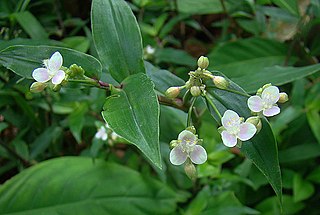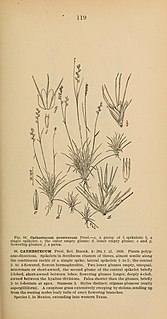
Milla, the Mexican star, is a genus of monocotyledonous plants in the family Asparagaceae, subfamily Brodiaeoideae. They are native mostly to Mexico, with one species extending into Guatemala, Honduras, Arizona, Texas and New Mexico.

Tigridia, is a genus of bulbous or cormous flowering plants belonging to the family Iridaceae. With common names including peacock flowers, tiger-flowers or shell flowers, they have large showy flowers; and one species, Tigridia pavonia, is often cultivated for this. The approximately 35 species in this family grow in the Americas, from Mexico to Chile. The tigridia flower is short lived, each often blooming for only one day, but often several flowers will bloom from the same stalk. Usually they are dormant during the winter dry-season. The roots are edible and were eaten by the Aztecs of Mexico who called it cacomitl, and its flower ocēlōxōchitl "jaguar flower". The genus name Tigridia means "tiger-like", and alludes to the coloration and spotting of the flowers of the type species Tigridia pavonia.
Ophellantha is a genus of plants under the family Euphorbiaceae first described as a genus in 1924. It is native to southern Mexico and northern Central America.
- Ophellantha spinosaStandl. - Honduras, El Salvador, Chiapas, Veracruz
- Ophellantha steyermarkiiStandl. - Guatemala, Chiapas

Echinodorus subalatus is a species of aquatic plants in the Alismataceae. It is native to Cuba, Mexico, Central America, Guyana, Venezuela, Bolivia, Brazil and Paraguay. It is found naturally growing in mud by the side of streams.

Commelina tuberosa is an herbaceous plant in the dayflower family native to Mexico but grown worldwide as an ornamental plant. It is characterized by its purple-splotched spathes with free margins, its bright blue petals of equal size, its tuberous roots, and its four to ten flowered lower cymes. In the wild, it is encountered in moist fields, open forests, or pine-oak forests. The species is sometimes considered to include the species Commelina coelestis, Commelina dianthifolia, and Commelina elliptica, such as in the Flora Mesoamericana. When these are treated as separate, they are often referred to as the "Commelina tuberosa complex". Horticulturally, the species are often treated as separate entities because of their differing habits and leaf shapes. In this sense, Commelina tuberosa is a low-growing plant with long narrow leaves.
Chamguava is a genus of the botanical family Myrtaceae, first described as a genus in 1991. It is native to southern Mexico and Central America.
- Chamguava gentlei(Lundell) Landrum - Chiapas, Belize, Guatemala, Honduras
- Chamguava musarum(Standl. & Steyerm.) Landrum - Guatemala
- Chamguava schippii(Standl.) Landrum - Guerrero, Chiapas, Belize, Guatemala, Panama

Hypolytrum is a genus of plant in the family Cyperaceae. It contains approximately 60–70 species, native to tropical Africa, Asia, Australia, Latin America and various oceanic islands.

Halodule is a genus of plants in the family Cymodoceaceae described as a genus in 1841. It is widespread on tropical and semi-tropical ocean shores of all continents except Europe and Antarctica.

Tradescantia spathacea, the boatlily or Moses-in-the-cradle, is a herb in the Commelinaceae family first described in 1788. It is native to Belize, Guatemala, and southern Mexico but widely cultivated as an ornamental and naturalized in parts of Florida, Texas, Hawaii, and various oceanic islands.
Billbergia viridiflora is a plant species in the genus Billbergia native to Tabasco, Belize and Guatemala.

Pitcairnia atrorubens is a species of flowering plant in Bromeliaceae family. It is native to Costa Rica, Panama, Honduras, Guatemala, Colombia, and western Mexico as far north as Nayarit.

Pitcairnia wendlandii is a flowering plant in the Bromeliaceae family. It is native to Costa Rica, Panama, Honduras, Guatemala and Chiapas.

Tinantia is a genus of plants in the Commelinaceae, first described in 1839. They are commonly called widow's tears or false dayflowers due to their resemblance of the closely related true dayflowers of the genus Commelina. Tinantia is native to North and South America from Texas + Hispaniola to Argentina, with a center of diversity from Mexico to Nicaragua. Tinantia pringlei, an alpine native of Mexico, is grown as an ornamental in temperate areas and is also a common greenhouse weed.
Galium orizabense is a species of plants in the family Rubiaceae, named for the town of Orizaba in Veracruz, where the first collections of the species were made. The species is native to Mexico, Costa Rica, Guatemala, Panamá, Venezuela, Colombia, and Hispaniola, plus widely scattered locations in the southeastern United States.

Echinodorus grisebachii or Echinodorus amazonicus is commonly known as Amazon sword plant, although other plants are also known under this common name. The aquatic plant is cultivated for and used in ponds and artificial aquatic habitats. It is native to Cuba, Central America, and South America as far south as Brazil and Bolivia.

Tripogandra is a genus of flowering plants in the spiderwort family, Commelinaceae. It is native to the Western Hemisphere from central Mexico and the West Indies south to Argentina.
Dictyostega is a genus of flowering plants in the Burmanniaceae, first described as a genus in 1840. It contains only one known species, Dictyostega orobanchoides, native to southern Mexico, Central America, Trinidad, and South America ).

Limnobium, common names spongeplant and American frogbit, is a group of aquatic plants in the Hydrocharitaceae described as a genus in 1814. It is widespread in freshwater environments in Latin America, the West Indies, and the United States.

Cathestecum is a genus of the North American plants in the grass family.














